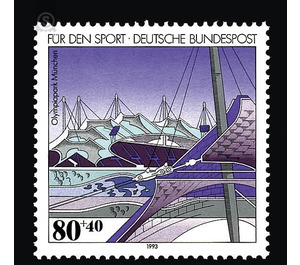sport aid - Germany / Federal Republic of Germany 1993 - 80 Pfennig
Theme: Architecture
| Country | Germany / Federal Republic of Germany |
| Issue Date | 1993 |
| Face Value | 80.00 |
| Color | blue |
| Perforation | K 13 3/4 |
| Printing Type | Multicolor offset printing |
| Stamp Type | Postage stamp |
| Item Type | Stamp |
| Chronological Issue Number | 1524 |
| Chronological Chapter | GER-BRD |
| SID | 237805 |
| In 30 Wishlists | |
In 1966, the International Olympic Committee awarded the Games of XX. 1972 Olympics in Munich - in a city that had until then no large sports buildings. In six years, here at the feet of the 289.53-meter-high Olympic Tower, the Olympic Park - an ensemble of modern stadiums and sports halls, as well as the Olympic Village, the Press City and the Press Center were built here - on the former military training ground and Oberwiesenfeld Airport. The buildings are embedded in an artificial landscape with a lake of around 80,000 square meters, a forum with wide lawns, avenues, tree and bush groups. The idea of the architects Günther Behnisch and Partner from Stuttgart, the almost 75,000 square meter tent roof, became the world famous landmark of modern Munich; Professor Grzimek from Kassel was responsible for the landscape design. Twenty years after the Olympics, the Olympic Park is one of the leading venues in Europe. The sports and leisure park now registers 90 million paying visitors, of which 42.5 million came to 5,000 sporting, cultural and commercial events and another 47.5 million visited the permanent operations such as the Olympic ice sports center or the Olympic swimming pool. Twenty world, nine European and more than 60 German championships have taken place here over the past two decades, as well as innumerable pop concerts, shows, ice reunions, football matches, tennis tournaments such as Davis Cup matches or the Grand Slam Cups, exhibitions and congresses , Not counting the number of visitors are the hundreds of thousands of recreational athletes, tourists and walkers who populate the freely accessible Olympic Park every year. The Munich Olympiapark, Munich's gift for the century, has become a fascinating part of the life of the Bavarian capital.


